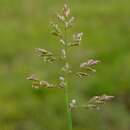More info for the terms:
density,
fire frequency,
frequencySeason of burning and frequency of burning greatly influence Canada
bluegrass postfire recovery. Dormant-season fires favor Canada
bluegrass, and biomass and density may increase during postfire year 1.
Late spring burning, when plants are actively growing, reduces biomass
and density during postfire year 1, but biomass and density may return
to preburn levels within 1 or 2 years. Thus Canada bluegrass often
recovers within 1 or 2 years after a single late spring fire, but
density and biomass are progressively reduced if burned annually or
biennially in late spring.
In abandoned fields in southern Wisconsin, Canada bluegrass flowering
stem density was reduced 50 percent when burned annually in May for 5
years. Conversely, flowering stem density increased 170 and 440
percent following 5 years of annual burning in March or October,
respectively [
4]. A similar study in southern Wisconsin found that 3
years of annual burning in mid-May reduced Canada and Kentucky bluegrass
flowering stem density by 70 percent, while late March or early April
burning had little affect on flowering [
14].
In a reconstructed tallgrass prairie in Illinois, bluegrass (Poa
compressa and P. pratensis combined) percent relative biomass decreased
as fire frequency increased in two communities as follows [
11]:
Burning Treatment*
not burned burned twice burned burned
3 times 4 times
Community type
big bluestem 23.4** 18.3 4.6 0
indiangrass 18.6 15.9 3.3 0
*not burned = unburned for 19 years
burned twice = burned Feb. 28, 1952 and April 16, 1959
burned three times = burned Feb. 28, 1952; April 16, 1959; and May 2, 1961
burned four times = burned Feb. 28, 1952; April 16, 1959; May 2, 1961; and
May 10, 1962
**sampled at the end of the 1962 growing season
In oak (Quercus spp.) woods and goldenrod (Solidago spp.) fields
accidently burned between April 6 and May 2 in south-central New York,
Canada bluegrass frequency increased from 6 to 17 percent and 56 to 81
percent, respectively, 10 to 26 months after burning [
28].
After early May prescribed burning in seral brushfields in northern
Idaho, Canada bluegrass recovered rapidly on lightly burned plots.
During the first postfire growing season, it produced the bulk of grass
biomass on lightly burned plots, which was 135 pounds per acre (151
kg/ha). In comparison, grass production on heavily burned and control
plots averaged only 0.7 and 10.2 pounds per acre (0.8 and 11.4 kg/ha),
respectively [
17].

